Conceptual Approach to Combustor Nozzle and Reformer Characteristics for Micro-Gas Turbine with an On-Board Reforming System: A Novel Thermal and Low Emission Cycle
Abstract
:1. Introduction
- Better fuel flexibility.
- Diluted concentration of internal oxidant through exhaust gas recirculation (EGR).
- Reduced nitrogen oxide emissions through low-temperature combustion.
- A higher combustion temperature when generating thermal NOX.
- A lower efficiency required for production and storage owing to the large volume per unit mass.
2. Methodologies
2.1. Modeling Description
2.2. SAGE Chemistry Model
2.3. Concept Nozzle Determination
2.3.1. Reference Single Nozzle Specification for H-Class Gas Turbine
2.3.2. Down-Scaled Single Nozzle Specification for the Present Study
2.4. Concept of Reformer Determination
2.5. Hydrogen Addition on Down-Scaled Nozzle
3. Results and Discussion
3.1. Reference Nozzle Analysis Results
3.2. Down-Scaled Nozzle Analysis Results
3.3. Hydrogen Yield From Reformer Study
3.4. Hydrogen Addition on Combustor Nozzle
Internal OH Distribution of Combustor
4. Conclusions
- Based on the reference nozzle for a heavy-duty gas turbine, a down-scaled nozzle was designed and analyzed. The main characteristics of the down-scaled nozzle are a DLN (dry low NOX)-type with high swirl with a perfect mixing concept to obtain a lean premixed combustion. A down-scaled nozzle had an average TIT of 1209 K, which was satisfied within ±5% of the reliability range of the combustor model with a target TIT of 1200 K. In addition, the NOx emission less than the target NOx emission of 5 ppm was satisfied, and the pressure loss at the inlet to outlet reached 1.2%.
- To design the conceived reformer, mass balance calculations considering the closed-loop cycle with reformed EGR and operating conditions were found. By conducting a parametric study for the reformer design, the hydrogen yield was mapped and the design point was selected. The conceived reformer can meet the proper hydrogen yield, reflecting 20% of the maximum target hydrogen content in volume percent considering an inlet pressure of 4.5 bar at the maximum load. It seems that the reforming process was dominantly driven by partial a non-catalytic oxidation.
- With the feasible hydrogen yield obtained from a previous study, hydrogen additions with various O2 diluted conditions were described using a down-scaled nozzle. By increasing the hydrogen addition and decreasing the O2 fraction, OH concentrations were decreased and widely distributed, which was similar to the fundamental characteristics of a MILD combustion.
- The remaining task of this study is to convert the model from an open-loop to a closed-loop cycle. To realize the closed-loop cycle shown in Figure 15, the key idea is to induce the reformed gas directly into the inner passage of the nozzle by force, which is expressed as a box in Figure 15. To make sense of this, a specific auxiliary component will be introduced in a future study. Moreover, the reformed EGR control layout will be also included.
- For further work, a lab-scale test is planned to verify the flame structure obtained from the present work.
Author Contributions
Funding
Conflicts of Interest
Abbreviations
| Turbulent kinetic energy | |
| Rate of dissipation of turbulent kinetic energy | |
| n! | Factorial of n |
| th derivate of evaluated at point | |
| Pre-exponential factor | |
| Activation energy | |
| Source term | |
| AMR | Adaptive mesh refinement |
| CDC | Colorless distribution combustion |
| CFD | Computational fluid dynamic |
| CLP | Combustion loading parameter |
| CO | Carbon monoxide |
| CO2 | Carbon dioxide |
| COT | Combustor outlet temperature |
| DLN | Dry low NOX |
| EGR | Exhaust gas recirculation |
| HILS | Hardware in the loop simulation |
| LBO | Lean blow out |
| MILD | Moderate or intensive low oxygen dilution |
| NOX | Nitrogen oxides |
| OH | Hydroxy group |
| SS | Swirl support |
| TIT | Turbine inlet temperature |
| 3D | Three dimensional |
References
- Demirbas, A. Carbon dioxide emissions and carbonation sensors. Energy Sources Part A 2008, 30, 70–78. [Google Scholar] [CrossRef]
- Demirbas, A. Potential applications of renewable energy sources, biomass combustion problems in boiler power systems and combustion related environment issues. Prog. Energy Combust. Sci. 2005, 31, 171–192. [Google Scholar] [CrossRef]
- Rasul, M.G.; Khan, M.M.K. A review on technologies for reducing CO2 emission from coal fired power plants. Therm. Power Plants 2012. [Google Scholar] [CrossRef] [Green Version]
- Okokpujie, I.; Fayomi, O.; Oyedepo, S. The role of mechanical engineers in achieving sustainable development goals. Procedia Manuf. 2019, 35, 782–788. [Google Scholar] [CrossRef]
- U.S. Energy Information Administration (EIA). Annual Energy Outlook 2018 with Projection to 2050. Available online: https://www.eia.gov/outlooks/aeo/pdf/AEO2018.pdf (accessed on 6 February 2018).
- Hasemann, S.; Huber, A.; Naumann, C.; Aigner, M. Investigation of a FLOX®-based combustor for a micro gas turbine with exhaust gas recirculation. In Proceedings of the ASME Turbo Expo 2017 Turbomachinery Technical Conference and Exposition, Charlotte, NC, USA, 26–30 June 2017; American Society of Mechanical Engineers: New York, NY, USA, 2017. GT2017-64396. [Google Scholar]
- Kruse, S.; Kerschgens, B.; Berger, L.; Varea, E.; Pitsch, H. Experimental and numerical study of MILD combustion for gas turbine applications. Appl. Energy 2015, 148, 456–465. [Google Scholar] [CrossRef]
- Verhelst, S. Recent progress in the use of hydrogen as a fuel for internal combustion engines. Int. J. Hydrogen Energy 2014, 39, 1071–1085. [Google Scholar] [CrossRef] [Green Version]
- Zhai, X.; Liu, K.; Yao, Q. New Energy Technology; Chemical Industry Press: Beijing, China, 2010. [Google Scholar]
- Sun, Z.Y. Structure of turbulent rich hydrogen-air premixed flames. Int. J. Energy Res. 2015, 35, 2727–2791. [Google Scholar] [CrossRef]
- Tüchler, S.; Dimitriou, P. On the capabilities and limitations of predictive, multi-zone combustion models for hydrogen-diesel dual fuel operation. Int. J. Hydrogen Energy 2019, 44, 18517–18531. [Google Scholar] [CrossRef]
- Zhou, H.; Li, X.; Lee, C.F. Investigation on soot emissions from diesel-CNG dual-fuel. Int. J. Hydrogen Energy 2019, 44, 9438–9449. [Google Scholar] [CrossRef]
- Zhang, C.; Zhou, A.; Shen, Y.; Li, Y.; Shi, Q. Effects of combustion duration characteristic on the brake thermal efficiency and NOx emission of a turbocharged diesel engine fueled with diesel-LNG dual-fuel. Appl. Therm. Eng. 2017, 127, 312–318. [Google Scholar] [CrossRef]
- Meziane, S.; Bentebbiche, A. Numerical study of blended fuel natural gas-hydrogen combustion in rich/quench/lean combustor of a micro gas turbine. Int. J. Hydrogen Energy 2019, 44, 15610–15621. [Google Scholar] [CrossRef]
- Koten, H. Hydrogen effects on the diesel engine performance and emissions. Int. J. Hydrogen Energy 2018, 43, 10511–10519. [Google Scholar] [CrossRef]
- Nag, S.; Sharma, P.; Gupta, A.; Dhar, A. Experimental study of engine performance and emissions for hydrogen diesel dual fuel engine with exhaust gas recirculation. Int. J. Hydrogen Energy 2019, 44, 12163–12175. [Google Scholar] [CrossRef]
- Ceviz, M.A.; Sen, A.K.; Küleri, A.K.; Öner, I.V. Engine performance, exhaust emissions, and cyclic variations in a lean-burn SI engine fueled by gasoline–hydrogen blends. Appl. Therm. Eng. 2012, 36, 314–324. [Google Scholar] [CrossRef]
- Elkady, A.M.; Evulet, A.; Brand, A.; Ursin, T.P.; Lynghjem, A. Exhaust gas recirculation in DLN F-class gas turbines for post-combustion CO2 capture. In Proceedings of the ASME Turbo Expo 2008 Turbomachinery Technical Conference and Exposition, Berlin, Germany, 9–13 June 2008; American Society of Mechanical Engineers: New York, NY, USA, 2008. GT2008-51152. [Google Scholar]
- Han, S.; Park, M.; Song, S.; Chun, K.M. Experimental and numerical study of detailed reaction mechanism optimization for syngas (H2 + CO) production by non-catalytic partial oxidation of methane in a flow reactor. Int. J. Hydrogen Energy 2010, 35, 8762–8771. [Google Scholar] [CrossRef]
- Li, G.; Zhong, H.G.; Wu, Q. Study on integrating a gas turbine in steam methane reforming process. Appl. Therm. Eng. 2016, 99, 919–927. [Google Scholar] [CrossRef]
- Woo, S.; Baek, S.; Lee, K. On-board LPG reforming system for an LPG hydrogen mixed combustion engine. Int. J. Hydrogen Energy 2020, 45, 12203–12215. [Google Scholar] [CrossRef]
- Bogarra, M.; Herreros, J.M.; Tsolakis, A.; York, A.; Millington, P. Study of particulate matter and gaseous emissions in gasoline direct injection engine using on-board exhaust gas fuel reforming. Appl. Energy 2016, 180, 245–255. [Google Scholar] [CrossRef] [Green Version]
- Smith, G.P.; Golden, D.M.; Frenklach, M.; Moriarty, N.W.; Eiteneer, B.; Goldenberg, B.; Bowman, C.T.; Hanson, R.K.; Song, S.; Gardiner, W.C., Jr.; et al. GRI-Mech 3.0. Available online: http://www.me.berkeley.edu/gri_mech/ (accessed on 11 December 2020).
- Saboohi, Z.; Ommi, F.; Fakhrtabatabaei, A. Development of an augmented conceptual design tool for aircraft gas turbine combustors. Int. J. Multiphysics 2016, 10, 53–74. [Google Scholar] [CrossRef] [Green Version]
- Mestre, A.; Cadiou, A. Design and experimentation of a combustor for high combustion intensity. ASME 1985, 85, GT-51. [Google Scholar]




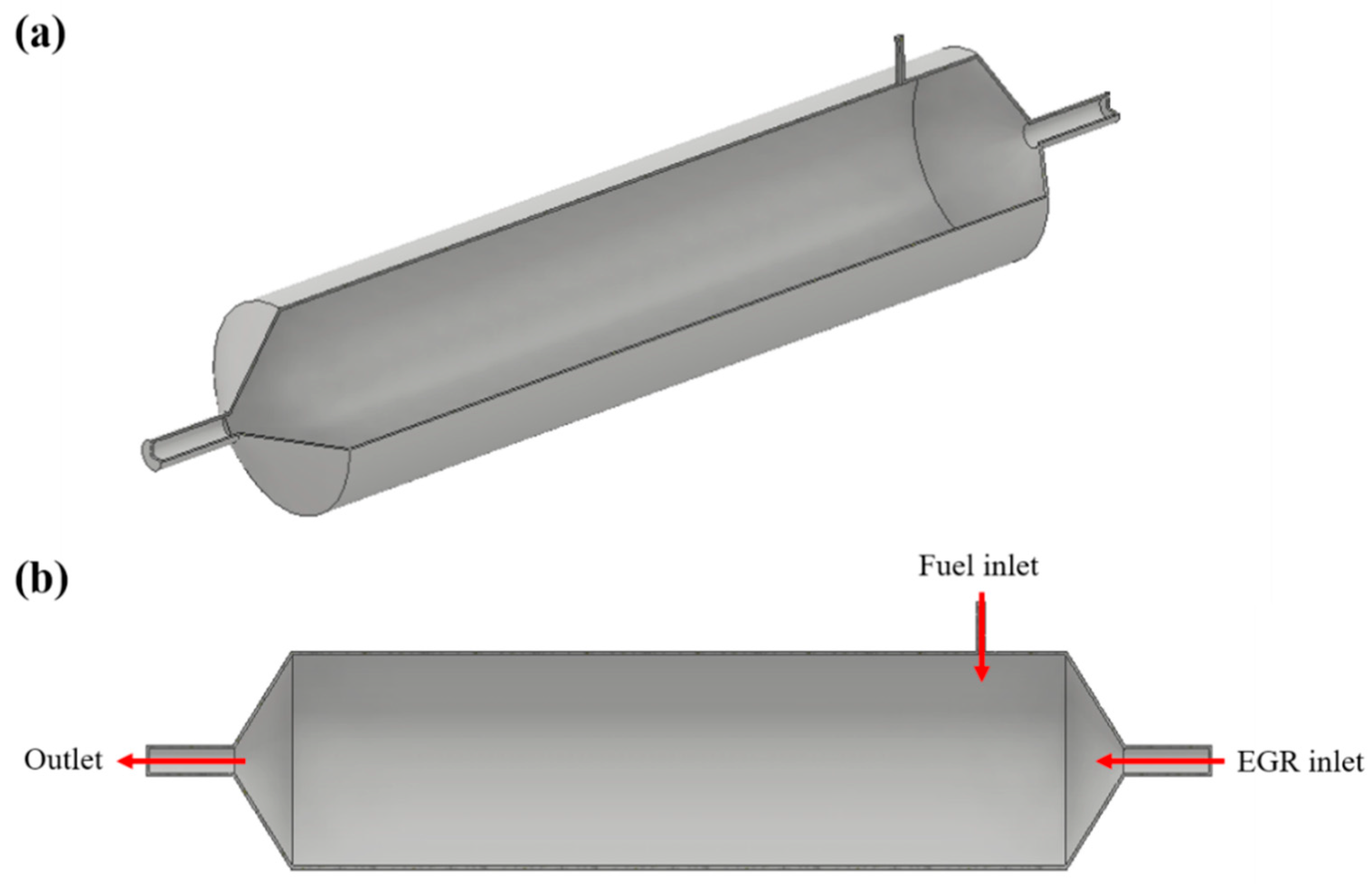
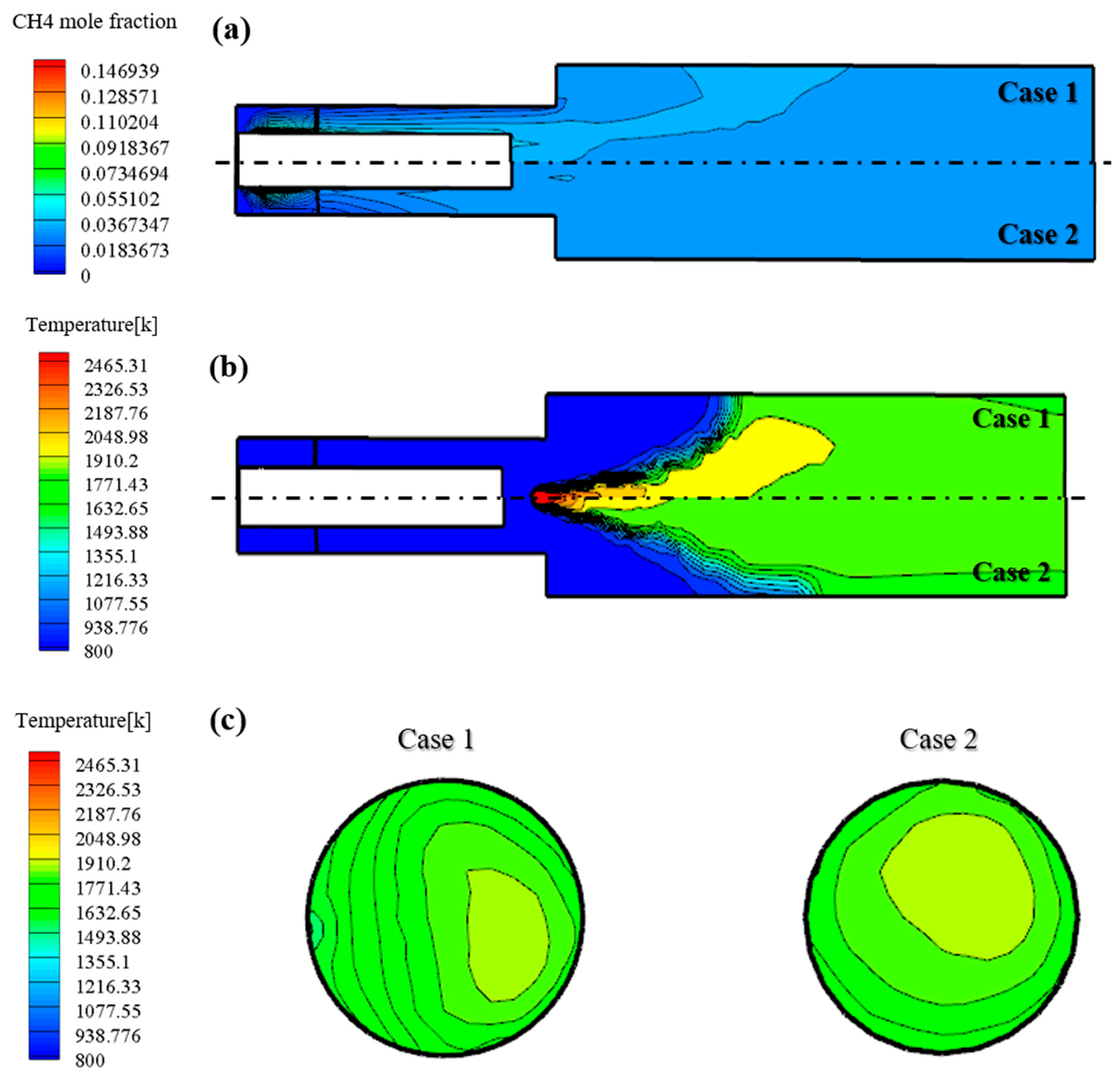
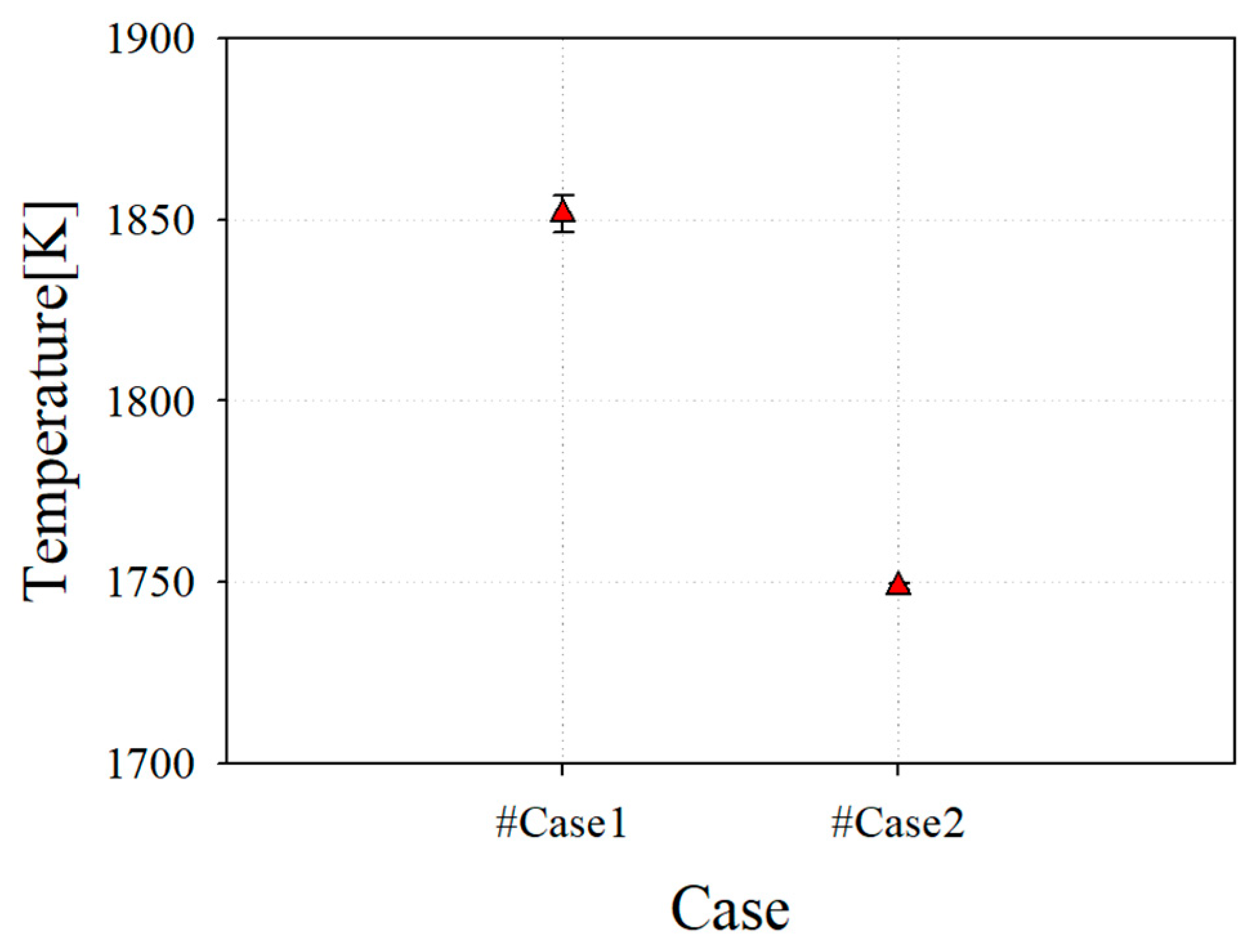

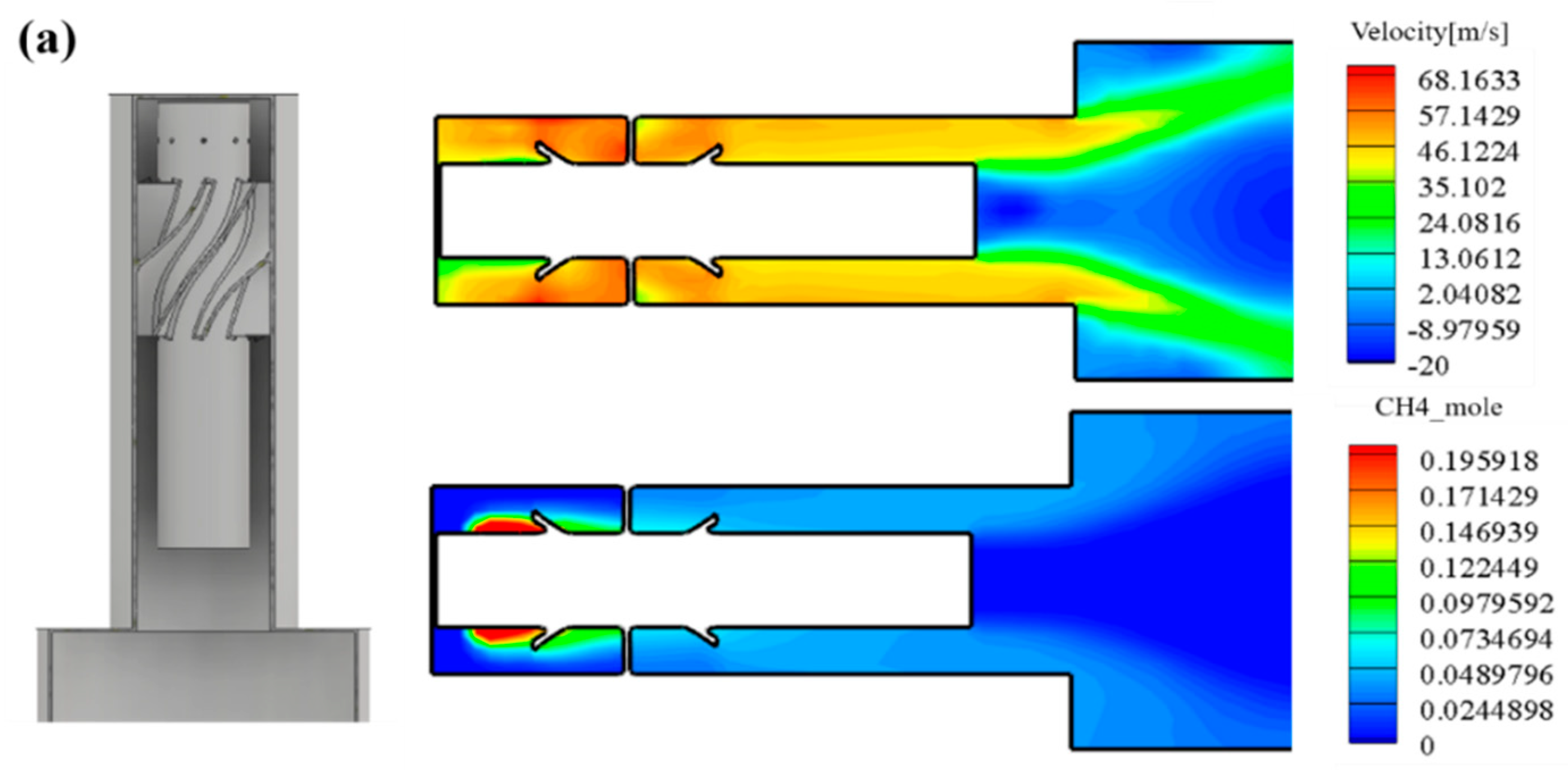
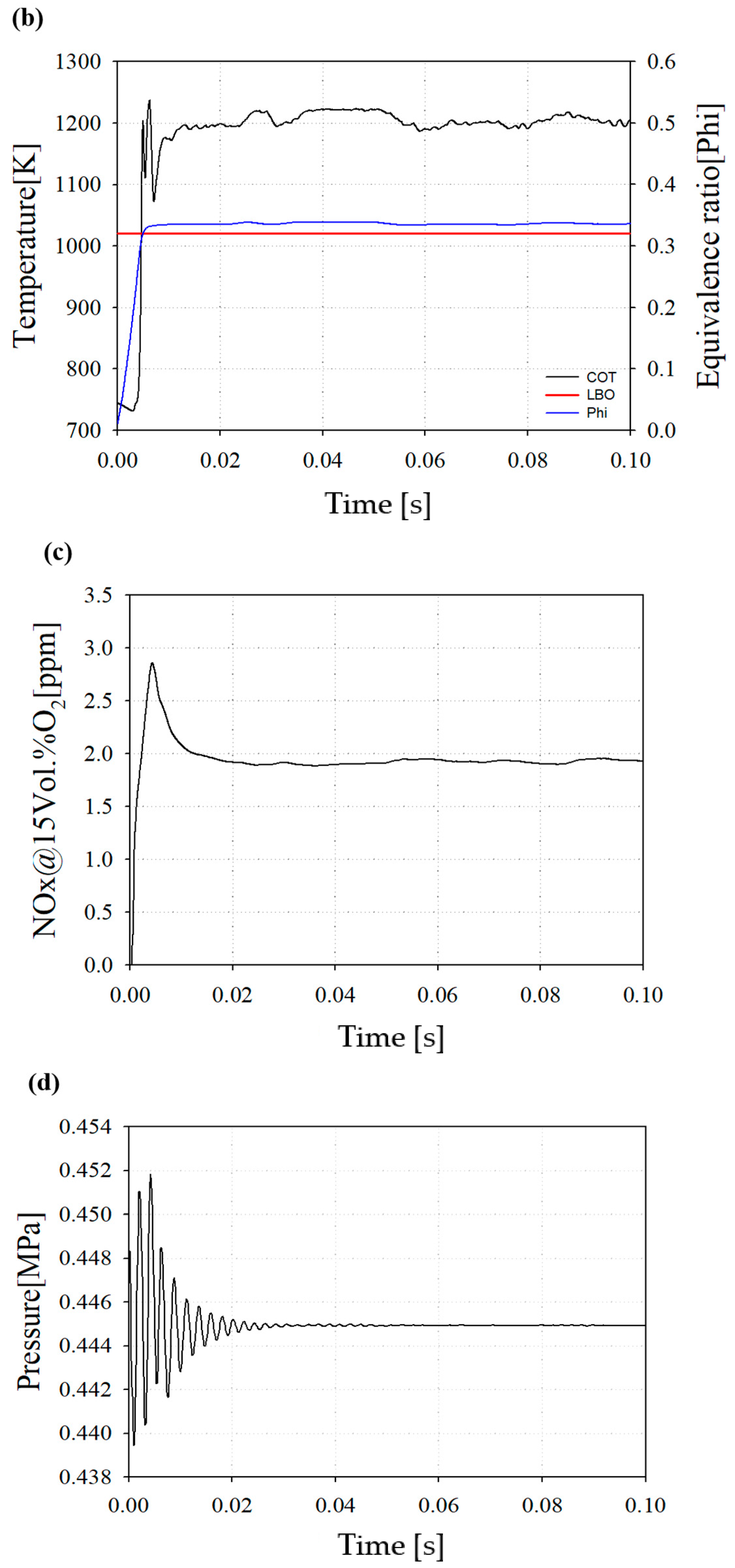
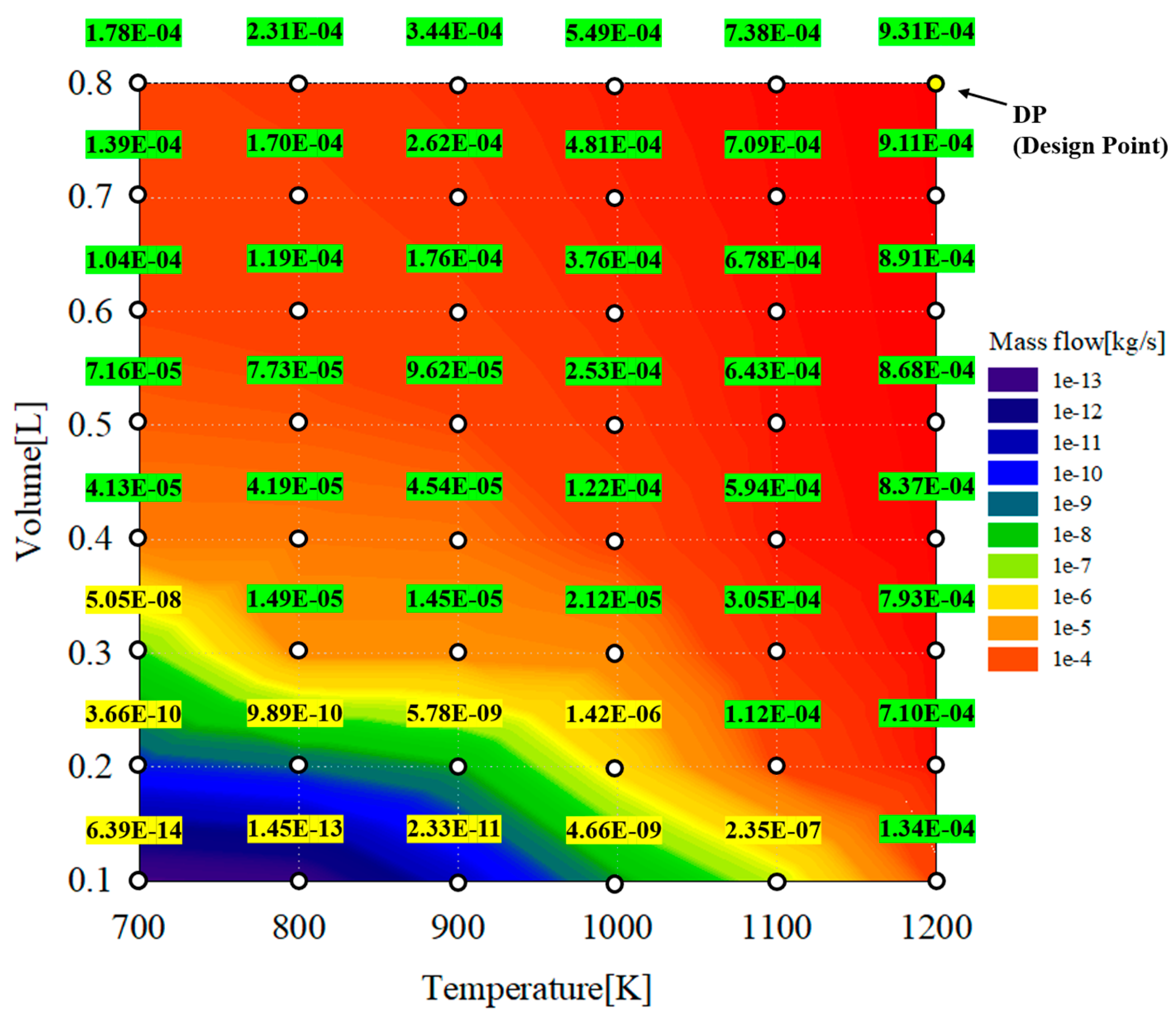
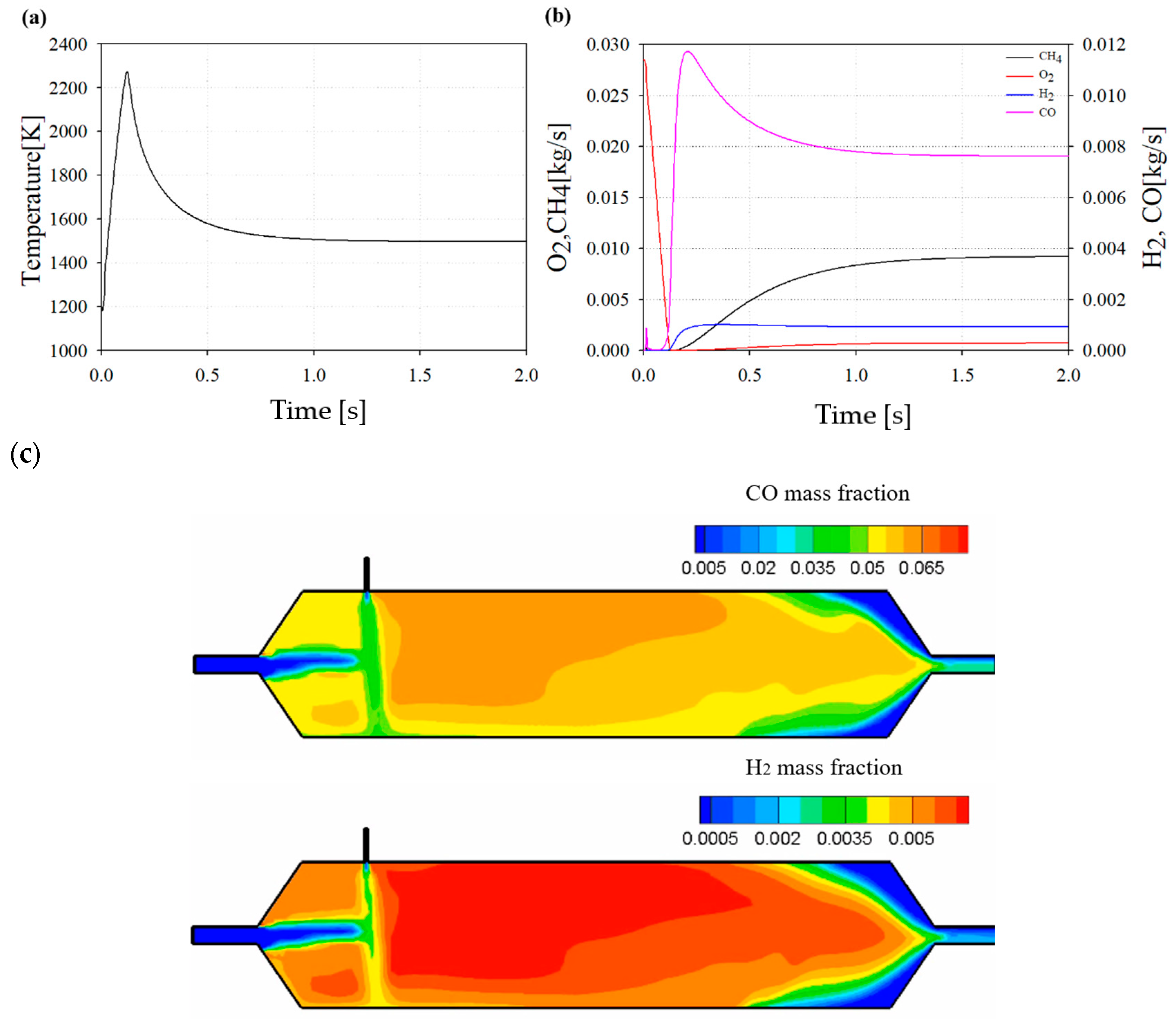


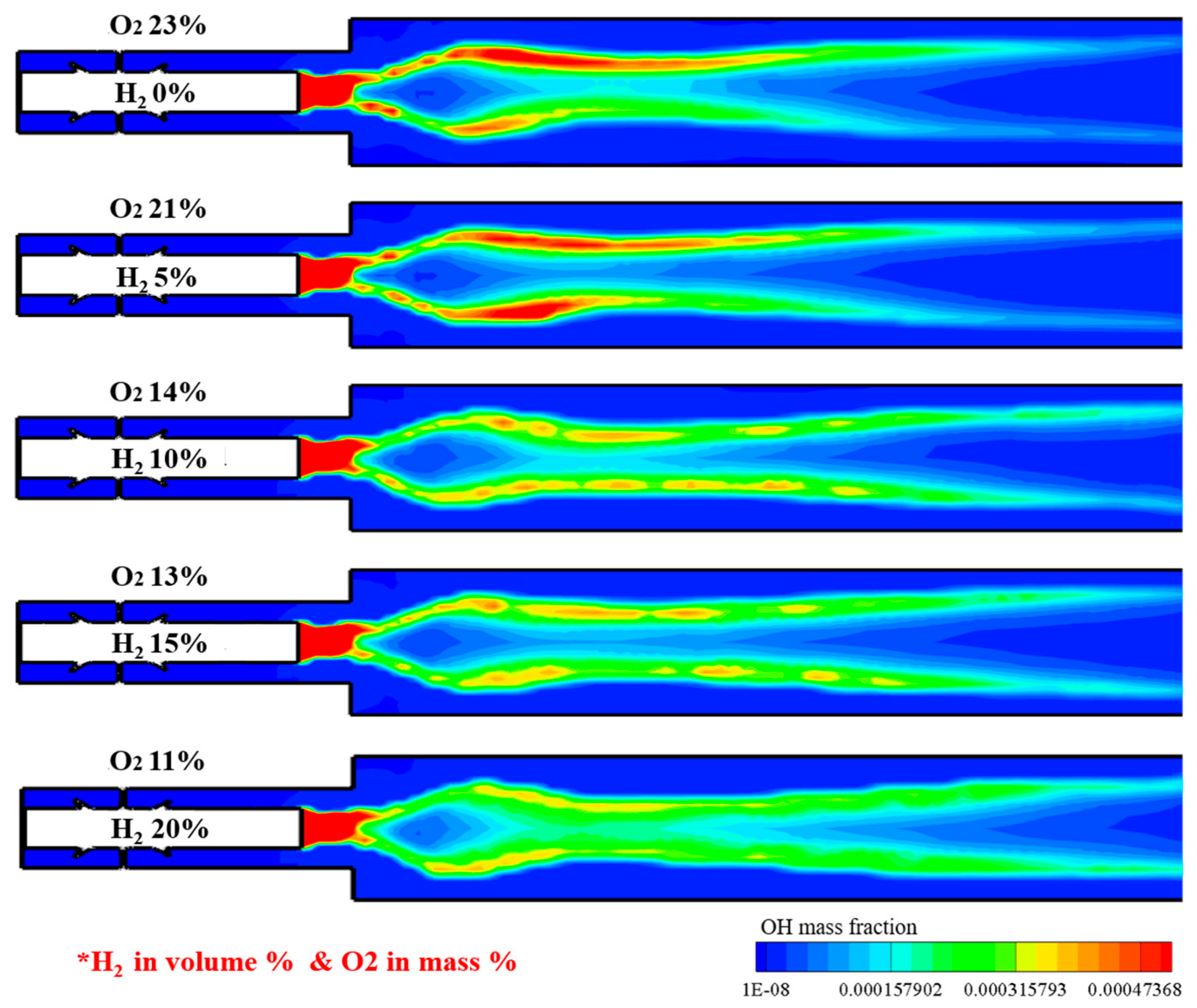

| Component | Symbol | Volumetric % |
|---|---|---|
| Methane | 94.42 | |
| Ethane | 2.29 | |
| Propane | 0.03 | |
| Butane | 0.25 | |
| Carbon dioxide | 0.57 | |
| Nitrogen | 0.44 | |
| Others | - | 2.0 |
| Item | Symbol (Unit) | Value | |
|---|---|---|---|
| Air | Mass flow rate (kg/s) | 7.8 | |
| Inlet pressure (bar) | 24 | ||
| Inlet temperature (K) | 750 | ||
| Inlet velocity (m/s) | 40 | ||
| Fuel | Mass flow rate (kg/s) | 0.24 | |
| Temperature (K) | 500 | ||
| ϕ | - | 0.53 | |
| Swirler | Length (mm) | 150 | |
| Swirl number (-) | Case 1 | Case 2 | |
| 0.215 (perfect mixing type + low swirl) | 0.663 (perfect mixing type + high swirl) | ||
| Mixing length (mm) | 350 | ||
| Target turbine inlet temperatue (TIT) | Temperature (K) | 1873 | |
| Item | Symbol (Unit) | Value |
|---|---|---|
| Air | Mass flow rate (kg/s) | 0.145 |
| Inlet pressure (bar) | 4.5 | |
| Inlet temperature (K) | 743 | |
| Fuel | Mass flow rate (kg/s) | 0.003 |
| Temperature (K) | 498 | |
| ϕ | - | 0.335 |
| Swirler | Length (mm) | 46 |
| Target TIT | Temperature (K) | 1200 |
| Target NOx | ppm | <5 ppm |
| Parameters | Units | Ranges | Interval | # of Case |
|---|---|---|---|---|
| Reaction temperature | K | 700–1200 | 100 | 48 |
| Reformer volume | L | 0.1–0.8 | 0.1 |
Publisher’s Note: MDPI stays neutral with regard to jurisdictional claims in published maps and institutional affiliations. |
© 2020 by the authors. Licensee MDPI, Basel, Switzerland. This article is an open access article distributed under the terms and conditions of the Creative Commons Attribution (CC BY) license (http://creativecommons.org/licenses/by/4.0/).
Share and Cite
Kim, J.; Park, J. Conceptual Approach to Combustor Nozzle and Reformer Characteristics for Micro-Gas Turbine with an On-Board Reforming System: A Novel Thermal and Low Emission Cycle. Sustainability 2020, 12, 10558. https://doi.org/10.3390/su122410558
Kim J, Park J. Conceptual Approach to Combustor Nozzle and Reformer Characteristics for Micro-Gas Turbine with an On-Board Reforming System: A Novel Thermal and Low Emission Cycle. Sustainability. 2020; 12(24):10558. https://doi.org/10.3390/su122410558
Chicago/Turabian StyleKim, Jonghyun, and Jungsoo Park. 2020. "Conceptual Approach to Combustor Nozzle and Reformer Characteristics for Micro-Gas Turbine with an On-Board Reforming System: A Novel Thermal and Low Emission Cycle" Sustainability 12, no. 24: 10558. https://doi.org/10.3390/su122410558
APA StyleKim, J., & Park, J. (2020). Conceptual Approach to Combustor Nozzle and Reformer Characteristics for Micro-Gas Turbine with an On-Board Reforming System: A Novel Thermal and Low Emission Cycle. Sustainability, 12(24), 10558. https://doi.org/10.3390/su122410558





